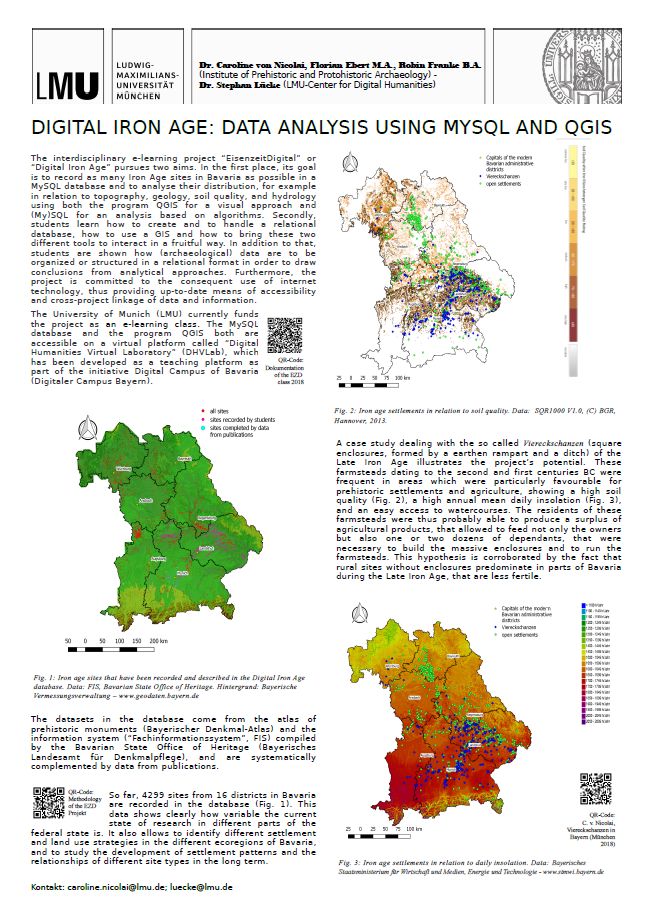1EisenzeitDigital ist auf dem "International Colloquium on Digital Archaeology" in Bern (4.-6.2.19) vertreten. Der im Folgenden präsentierte Themenvorschlag wurde vom Programmkomitee angenommen. Unterhalb des Themenvorschlags findet sich das auf dem Colloquium vorgestellte Poster.
2Caroline von Nicolai
(Institut für Vor- und Frühgeschichtliche Archäologie, LMU)
3
Stephan Lücke
(IT-Gruppe Geisteswissenschaften, LMU)
4Digital Iron Age: data analysis with MySQL and GQIS
5Abstract for application at the International Colloquium on Digital Archaeology
in Bern, Switzerland, 4th – 6th February 2019
6The interdisciplinary e-learning project “EisenzeitDigital” (EZD; see presentations of July 2017 and May 2018) or “Digital Iron Age” pursues two aims. In the first place, its goal is to record as many Iron Age sites in Bavaria as possible in a MySQL database and to analyse their distribution, for example in relation to topography, geology, soil quality, and hydrology using both the program QGIS for a visual approach and (My)SQL for an analysis based on algorithms. Secondly, students learn how to create and to handle a relational database, how to use a GIS and how to bring these two different tools to interact in a fruitful way. In addition to that, students are shown how (archaeological) data are to be organized or structured in a relational format in order to draw conclusions from analytical approaches. Furthermore, the project is committed to the consequent use of internet technology, thus providing up-to-date means of accessibility and cross-project linkage of data and information. In accordance to this commitment, teaching includes the use of a WordPress-Environment, where teachers and students alike present and share their work and have the possibility to comment and interact.
7The University of Munich (LMU) currently funds the project as an e-learning class. The MySQL database and the program QGIS both are accessible on a virtual platform called “Digital Humanities Virtual Laboratory” (DHVLab), which has been developed as a teaching platform as part of the initiative Digital Campus of Bavaria (Digitaler Campus Bayern) that is funded by the Bavarian Ministry of Education and Culture.
8The datasets in the database are drawn from the atlas of prehistoric monuments (Bayerischer Denkmal-Atlas) and the information system (“Fachinformationssystem”, FIS) compiled by the Bavarian State Office of Heritage (Bayerisches Landesamt für Denkmalpflege), and are systematically complemented by data from publications. The project “Digital Iron Age” thus allows to study the development of settlement patterns and the relationships of different site types in the long term, and to recognize different land use strategies in different parts of Bavaria.
9Beyond the scope of teaching students the use of the mentioned software tools and to fruitfully apply strategies of structuring and analysing data, the presented project aims at international cooperation in terms of building a pool of transboundary archaeological data that can be used by researchers. “Digital Iron Age” is an official partner of the France-based project BaseFer. The aim is to bring together archaeological (mainly Iron Age) data on a transnational basis.
10The running first term of funding by Lehre@LMU will end by end of March 2019. At a second stage, that will presumably start in October 2019 and the funding of which has already been agreed, the scope is to cooperate with the department of Statistics of the LMU (Prof. Helmut Küchenhoff), thus widening the methods of analysing the data so far gathered.

Das Projekt EisenzeitDigital, gefördert von lehre@LMU (Poster, präsentiert auf dem International Colloquium on Digital Archaeology in Bern)